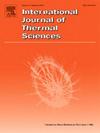涡轮叶片前缘不同通道流动与换热的非定常特性研究
IF 4.9
2区 工程技术
Q1 ENGINEERING, MECHANICAL
International Journal of Thermal Sciences
Pub Date : 2025-04-28
DOI:10.1016/j.ijthermalsci.2025.109962
引用次数: 0
摘要
本文采用大涡模拟(LES)方法,研究了三种雷诺数(6.0 × 103、9.0 × 103、1.2 × 104)下涡轮叶片前缘旋流冷却(SC)、撞击冷却(IC)、双室冷却(DC)三种内部结构的瞬时和时均流动和换热特性。与RANS方法相比,LES方法可以为内部冷却设计人员提供更全面的流动和传热理解。数值结果揭示了以下重要结论:(1)从时间平均来看,SC和DC的切向射流可以显著提高换热率(Nu),因此它们的换热率(Nu)高于IC,但IC的摩擦阻力最低。(2)从非定常分析来看,随着Re的增加,SC沿流动方向的流动不稳定性增加,而DC的流动不稳定性降低。IC的传热速率(Nu)不稳定性最高,在Re = 6.0 × 103时,IC的Nu波动幅度比SC提高了34.9%。本文章由计算机程序翻译,如有差异,请以英文原文为准。
Investigation on the unsteady characteristics of flow and heat transfer in different channels of turbine blade leading edge
In this work, the large eddy simulation (LES) method is used to study the instantaneous and time-averaged characteristics of flow and heat transfer in three internal structures i.e., swirl cooling (SC), impingement cooling (IC), double chamber cooling (DC) in the leading edge of a turbine blade at three Reynolds numbers (6.0 × 103, 9.0 × 103, 1.2 × 104). Comparison with RANS method, LES method can provide internal cooling designers with a more comprehensive understanding of flow and heat transfer. The numerical results reveal the following important conclusions: (1) At the view point of time-averaged, the tangential jet in SC and DC can significantly increase the heat transfer rate (Nu), and therefore their heat transfer rates (Nu) are higher than that of IC, but IC has the lowest friction resistance. (2) At the view point of unsteady analysis, the flow instability of SC along the flow direction increases with Re, while the flow instability of DC decreases. The heat transfer rate (Nu) instability of IC is the highest, at Re = 6.0 × 103, the Nu fluctuation amplitude of IC is increased by 34.9 % compared with SC.
求助全文
通过发布文献求助,成功后即可免费获取论文全文。
去求助
来源期刊

International Journal of Thermal Sciences
工程技术-工程:机械
CiteScore
8.10
自引率
11.10%
发文量
531
审稿时长
55 days
期刊介绍:
The International Journal of Thermal Sciences is a journal devoted to the publication of fundamental studies on the physics of transfer processes in general, with an emphasis on thermal aspects and also applied research on various processes, energy systems and the environment. Articles are published in English and French, and are subject to peer review.
The fundamental subjects considered within the scope of the journal are:
* Heat and relevant mass transfer at all scales (nano, micro and macro) and in all types of material (heterogeneous, composites, biological,...) and fluid flow
* Forced, natural or mixed convection in reactive or non-reactive media
* Single or multi–phase fluid flow with or without phase change
* Near–and far–field radiative heat transfer
* Combined modes of heat transfer in complex systems (for example, plasmas, biological, geological,...)
* Multiscale modelling
The applied research topics include:
* Heat exchangers, heat pipes, cooling processes
* Transport phenomena taking place in industrial processes (chemical, food and agricultural, metallurgical, space and aeronautical, automobile industries)
* Nano–and micro–technology for energy, space, biosystems and devices
* Heat transport analysis in advanced systems
* Impact of energy–related processes on environment, and emerging energy systems
The study of thermophysical properties of materials and fluids, thermal measurement techniques, inverse methods, and the developments of experimental methods are within the scope of the International Journal of Thermal Sciences which also covers the modelling, and numerical methods applied to thermal transfer.
 求助内容:
求助内容: 应助结果提醒方式:
应助结果提醒方式:


